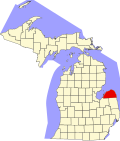2010 census
As of the census [6] of 2010, there were 267 people, 133 households, and 80 families living in the village. The population density was 264.4 inhabitants per square mile (102.1/km2). There were 201 housing units at an average density of 199.0 per square mile (76.8/km2). The racial makeup of the village was 93.3% White, 1.9% Native American, and 4.9% from two or more races. Hispanic or Latino of any race were 2.2% of the population.
There were 133 households, of which 16.5% had children under the age of 18 living with them, 48.9% were married couples living together, 8.3% had a female householder with no husband present, 3.0% had a male householder with no wife present, and 39.8% were non-families. 36.1% of all households were made up of individuals, and 24% had someone living alone who was 65 years of age or older. The average household size was 2.01 and the average family size was 2.58.
The median age in the village was 54.9 years. 15.7% of residents were under the age of 18; 6% were between the ages of 18 and 24; 14.6% were from 25 to 44; 29.3% were from 45 to 64; and 34.5% were 65 years of age or older. The gender makeup of the village was 49.8% male and 50.2% female.
2000 census
As of the census [2] of 2000, there were 310 people, 132 households, and 95 families living in the village. The population density was 308.7 inhabitants per square mile (119.2/km2). There were 203 housing units at an average density of 202.2 per square mile (78.1/km2). The racial makeup of the village was 98.71% White and 1.29% Native American. Hispanic or Latino of any race were 0.32% of the population.
There were 132 households, out of which 24.2% had children under the age of 18 living with them, 61.4% were married couples living together, 7.6% had a female householder with no husband present, and 28.0% were non-families. 25.8% of all households were made up of individuals, and 17.4% had someone living alone who was 65 years of age or older. The average household size was 2.32 and the average family size was 2.67.
In the village, the population was spread out, with 20.0% under the age of 18, 5.5% from 18 to 24, 20.3% from 25 to 44, 26.1% from 45 to 64, and 28.1% who were 65 years of age or older. The median age was 48 years. For every 100 females, there were 96.2 males. For every 100 females age 18 and over, there were 101.6 males.
The median income for a household in the village was $31,071, and the median income for a family was $34,167. Males had a median income of $26,875 versus $18,125 for females. The per capita income for the village was $16,428. About 5.6% of families and 4.6% of the population were below the poverty line, including none of those under age 18 and 6.0% of those age 65 or over.



